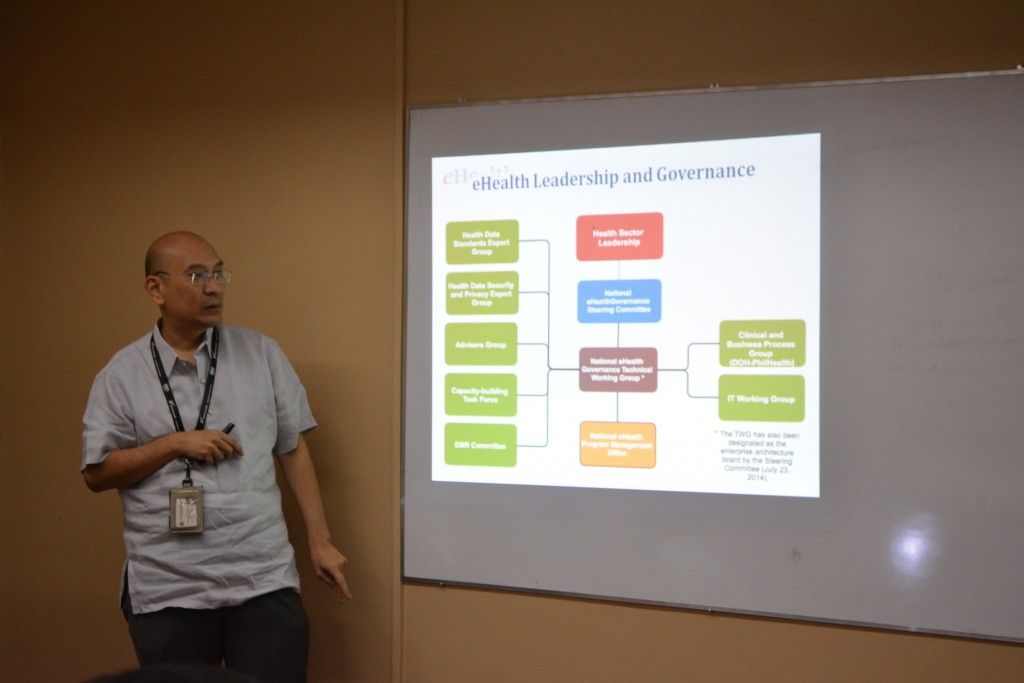UPM experts convene on next steps for telemedicine
February 13, 2015 4:50 pm | by Henri Joshua Igna, RN | Posted in News

Dr. Alvin Marcelo talks about the leadership and governance in eHealth during the "Next Steps for Telemedicine" Meeting (13 Feb 2015) (Photo by: Henri Igna)
Experts and clinical specialists assembled this morning to discuss the next steps of telemedicine in the Philippines. The 14 participants, coming from the University of the Philippines Manila and Philippine General Hospital, were given an overview of the current status of telemedicine in the country, as well as other telemedicine efforts that their colleagues from different institutes have embarked on.
Telemedicine, in its simplest definition, is the provision of medical care with the use of health data transmitted from a distance through ICT systems. At present, the National Telehealth Center under the University of the Philippines Manila – National Institutes of Health leads in the implementation of wide-scale telehealth programs in the Philippines, one of which is the National Telehealth Service Program (NTSP). In the NTSP, doctors in over 400 remote and rural areas are able to send teleconsults to clinical specialists in tertiary hospitals like PGH via SMS or Email. The center continuously exhausts its efforts in improving the system, both for the satisfaction of the patients, the referring doctors, and the clinical specialists.
Exciting updates were also presented by several participants on how they apply telemedicine in their respective research activities. Dr. Belen Dofitas from UP-PGH section of dermatology shared how teledermatology will be actively used in her research on leprosy, Tinea imbricata, and yaws, a skin disease thought to have been eradicated but actually endemic in Maguindanao. “With the collaboration of NTHC, Philippine Dermatological Society and the Department of health, it’s a bright future for teledermatology.”
[Read: “PDS and NTHC collaborates, trains new specialists for Teledermatology“]
Dr. Leo Cubillan from the Philippine Eye Research Institute described their partnership with Joslin on teleophthalmology. “It is unique because the telemedicine here includes processing of image. The idea is for non-doctors to be able to do it,” Dr. Cubillan explained. Every week, about 40 image sets are sent from the USA to PERI where local doctors process them. Currently, Dr. Cubillan and his team are looking on a possible different application, and involvement with Philhealth.
The use of mobile devices for health surveillance and data collection was also highlighted during the presentation of Dr. Anna Lena Lopez from the Institute of Child Health and Human Development. She shared the challenges and lessons in implementing MTB, a mobile-based surveillance system developed by ICHHD and NTHC specific for tuberculosis in accordance with the National Tuberculosis Program.
All ears are on Dr. Alvin Marcelo, a strong proponent of eHealth in the Philippines and director of UP Manila Technology Transfer and Business Development Office (TTBDO), as he shed light on the current steps being taken by the national government, led by the National eHealth Steering Committee, in implementing the Philippine Health Information Exchange. The PHIE allows the integration and interoperability of data from different institutions and health facilities, paving way for a broader spectrum of telemedicine innovations aiming to achieve better efficiency in health care delivery. The goal of the national eHealth steering committee is that “by 2020, eHealth will enable widespread access to health care services.”